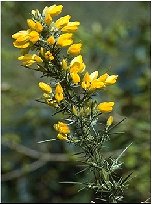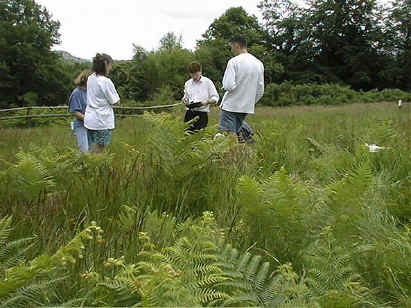 |
Gorse (Ulex
europaeus) was initially dominant in section 7 with a
mean % cover of 40%. Survey results indicate that by 1998, grasses had become dominant
while the mean % cover of Gorse in section 7 had declined to 4%. |
While these results indicated greatly decreased gorse
cover in section 7, this was somewhat misleading as gorse was actually still distributed
over fairly large areas in this section. The gorse, while widespread, did not uniformly
cover the area and was most abundant in the lower, eastern end of the section. (This is an
illustration of a phenomenon noticed many times while sampling. Namely that the vegetation
of the upper, western end of the project site was often markedly different to the lower,
eastern end. This was most likely to be due to the influence of the woodland on the
western border of the project site and to the gradient of the slope.)
A visual examination of section 7 quickly indicated that the initial
spot spraying with Garlon to control the gorse had been largely unsuccessful, despite the
contrary indications of the survey results.
- 20. Control
of Competing Species.
Roundup was used in both sections 8 and 9 initially, to remove species which might compete
with the Heather. While Heather is now extremely well-established in section 9, there was
a correspondingly low % cover of Heather in section 8. The use of Roundup does not
therefore appear to have had any significant promotional effect on heather establishment.
The use of Roundup resulted in a significantly lowered species diversity in section 8
initially. This effect was not noted in section 9. This may be accounted for by the fact
that section 9 was likely to be much more diverse than section 8 to begin with, because it
covers a much larger, more environmentally diverse area.
 |
- 21. Bracken
(left)
was present on the project site, but was not a problem.
It occurred mainly in the northern and southern sections adjacent to woodland.
|
- 22.
Roe Deer and rabbits feed on the project site. The additional effects of their grazing on
the vegetation of the site are unknown.
- 23. The
fauna on the heathland site has not yet been surveyed either qualitatively, or
quantitatively. However, a number of animals have been seen while carrying out the annual
vegetation surveys
Tiger Beetles (Cicindela campestris) which are very characteristic heathland
inhabitants, have occurred on the project site since 1996. Orthopterans (grasshoppers /
crickets) are abundant in the grasses in the summer. Numerous spiders and several species
of butterflies and dragonflies are commonly seen. Detailed qualitative and quantitative
surveys of the fauna of the project site are planned for the future.
- 24.
Conclusions
The development of heath vegetation on the project site is being
successfully promoted. Vegetation on the site was initially non-uniform as a result of
varying environmental conditions across the site.
The 1996 survey acted as a base-line survey to document these
initial environmental differences. By 1998, clearly observable differences between
sections had developed which were likely to be attributable to differing management
practices. However, the Heathland restoration project site is in the very early stages of
restoration and it will be some time before the longer term effects of the management
become apparent.
|